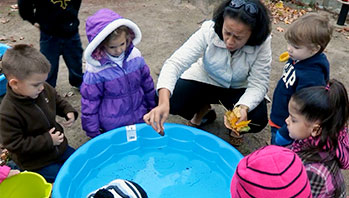- buckets of water
- chart paper
- clipboard
- containers (plastic buckets, bottles, and cups)
- marker
- pen
- squirt bottles
- absorb
- flow
- settle
- shape
MA Standards:
Language/L.PK.MA.6: Use words and phrases acquired through conversations, listening to books read aloud, activities, and play.
MA Draft STE Standards:
Earth and Space Sciences/Earth’s Systems/ESS2.A: Observe, investigate, and classify the non-living materials, natural and human made, in their environment.
Earth and Space Sciences/Earth’s Systems/ESS2.C: Explore and describe the different places water is found in the local environment.
Physical Sciences/Matter and Its Interactions: Structure and Properties of Matter/PS1.A: Describe, compare, sort and classify objects based on observable physical characteristics, uses, and whether it is manufactured as part of their classroom play and investigations of the natural and human-made world.
Head Start Outcomes:
Logic and Reasoning/Reasoning and Problem Solving: Classifies, compares, and contrasts objects, events, and experiences.
Science Knowledge/Conceptual Knowledge of Natural and Physical Worlds: Observes, describes, and discusses properties of materials and transformation of substances.
Science Knowledge/Scientific Skills and Method: Collects, describes, and records information through discussions, drawings, maps, and charts.
PreK Learning Guidelines:
English Language Arts/Language 2: Participate actively in discussions, listen to the ideas of others, and ask and answer relevant questions.
Science and Technology/Inquiry Skills 4: Record observations and share ideas through simple forms of representation such as drawings.
Science and Technology/Earth and Space Sciences 5: Compare and contrast natural materials such as water, rocks, soil, and living organisms using descriptive language.
Science and Technology/Physical Sciences 19: Explore, describe, and compare the properties of liquids and solids found in children's daily environment.
Explore Together (outdoors): Explore Water on Surfaces

© Commonwealth of Massachusetts, Department of Early Education and Care. All rights reserved.
STEM Key Concepts: You can use different objects to move water; Water behaves differently on different surfaces: Some surfaces absorb water, some don't; Water flows and it can be sprayed, squirted, splashed, and poured
ELA Focus Skills: Listening and Speaking, Vocabulary
Educator Prep: Prepare a two-column chart on chart paper. Label the left-hand column “Places to Pour Water” and the right-hand side “What happens?” You may want to provide water smocks for children to help keep them dry (garbage bags with holes for head and arms work well).
Safety Tips:
- Remind children to wash their hands before and after the activity.
- Be aware of and check for poison ivy, poison sumac, and thorny or prickly bushes before gathering children in a designated area.
You may want to begin by reviewing the basic water rules chart.
Things that are okay to do while exploring water:
- Explore water with your hands and various tools
- Observe water with your eyes and ears
- Touch water in puddles or other places only when an adult says it is okay
Things that are not okay to do while exploring water:
- Drink any water that we are exploring
- Purposely spray, splash, or pour water on any child (or on yourself)
Display the materials. Tell children that you are going to take them outdoors to explore water. Review what happened to the water when you poured it from the pitcher into the plastic container. (it flowed from the pitcher, settled in the container, and took on the shape of the container)
- Tell children they are going to use the available materials to explore pouring and squirting water on different surfaces and to observe what happens to the water.
- Help children generate a list of different outdoor surfaces outside the school. Record them on the left-hand column of the two-column chart. (e.g., dirt, grass, slide, blacktop, walls, plants, sidewalk, sand) Then ask children to predict what might happen when they pour water on each of these surfaces.
Have children help you take the materials outside. Ask volunteers to demonstrate using materials that are new or unfamiliar to children. As you introduce the exploration materials, introduce and use key vocabulary such as squirt, squeeze, spray, and pour. For example, say, I am squirting the water with a squirt bottle.
Invite children to use the materials to explore how water behaves on different surfaces. Encourage children to talk to one another about their explorations and observations, and to help one another use the exploration materials. As children explore, take photos and/or videos of their findings. Circulate, listen to, and engage children when you notice something of interest to them or if they need support. Ask questions such as,
- I notice the water made a hole in the sand when you squirted it with a strong squirt; what do you think will happen if you squirt the water with a gentle squirt?
- What does the water do when you pour in on the grass? The dirt? The cement?
Reflect and Share
Bring children back inside to share their observations. Review any photos and/or videos you took of children exploring. Display the two-column chart and have children describe what happened when they poured water on each surface. Record their responses in the right column of the chart. Ask questions such as,
- What happened to the water when you poured it on the dirt compared to when you poured it on the cement? Have children describe what they saw happen to the water when they poured it on the dirt. Say, The water was absorbed by the dirt. Let’s all say that word.
- How did the water behave differently when you squirted it with a strong squirt compared to when you squirted it with a gentle squirt?
- What did you observe when you poured the water on the different surfaces compared to when you squirted it on the surfaces?
Wrap up this discussion by pointing out that the water behaved differently on different surfaces. On some surfaces it was absorbed and on some it wasn’t. Even on the surfaces where it was absorbed, it was absorbed differently.
